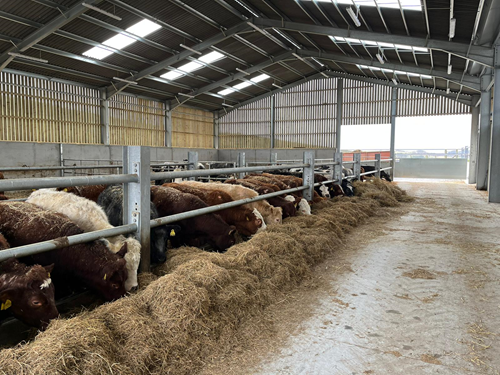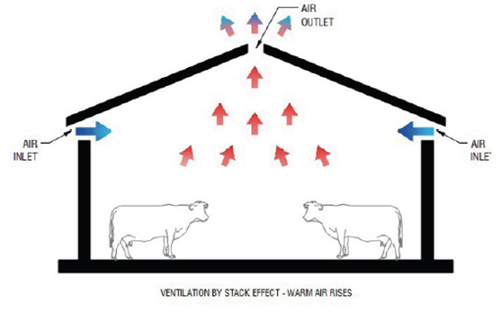Don’t Sweat It

Many farmers have had to house cattle earlier because of extended periods of wet weather, poached fields, limited grazing and variable -but often mild- temperatures. To ensure that good health and maximum performance is obtained from housed livestock the provision of effective ventilation is crucial.
There are three fundamental factors that should be controlled by ventilation within a shed to maintain ideal conditions for livestock.
Fresh air, that is as free from bacteria, dust and the gases produced by cattle as possible. Ammonia levels over 25ppm will aggravate mucous membranes and the respiratory tract, making the animals more vulnerable to respiratory diseases.
Excess moisture (especially topical this year!). Excess moisture can harbour harmful viruses and bacteria which can increase the risk of infection transmission and increase the prevalence of pneumonia and mastitis.
Draughts should be controlled by ventilation. Excessive air speeds around livestock will increase discomfort within a herd and the rate at which body heat is lost in cold weather. Sustained draughts will result in the cattle having to burn excess energy to stay warm. This can have a detrimental effect on the animal’s immune system and can also lead to a reduction in performance.
A well-ventilated shed will allow fresh air to be pulled in and stale air to be pushed out whilst avoiding draughts. This movement of air is driven by thermal buoyancy, more commonly known as the ‘stack effect’. The stack effect occurs when the heat generated by cattle warms the air, which causes the air to rise. The warm air that contains bacteria, dust and moisture escapes through the shed outlet. Fresh clean air is then drawn in through side wall inlets.

If there is insufficient outlet, the warm air will fail to escape the shed, cooling before falling back down onto bedding, increasing the moisture content and providing the ideal environment for bacteria to flourish. At a relative humidity of over 75%, viruses and bacteria can survive for sustained periods of time, increasing the spread of disease between animals.
If there is insufficient inlet, there won’t be enough cool, fresh air drawn into the shed. Warm air will rise more slowly, giving it time to cool before reaching the outlet, which allows pathogens and water to stay in the shed.
A cow requires 0.1m2 of ridgeline outlet and growing cattle and calves require 0.04m2 of outlet, the area of required inlet is double that of the outlet (0.2m2/cow and 0.08m2/calf). Very young, small calves will not generate enough body heat for the stack effect to work. Mechanical ventilation such as a fan and tube system would be more practical in a calf house.
You can test your sheds’ ventilation by using a smoke bomb to observe how quickly the smoke escapes from the shed. If the air clears within 60 seconds, this will indicate there is adequate ventilation. If the smoke takes over 60 seconds to leave the shed this would signal that alterations could be made to improve airflow. A well-ventilated shed can help reduce straw wastage and increase productivity of livestock by up to 5%, which makes any investment in shed alteration worthwhile.
5 Top Tips
- Use a smoke bomb to observe how quickly air escapes your livestock shed.
- Clip the backs of cattle at housing to reduce sweating and the risk of pneumonia spreading.
- Consider lowering the stocking density of a shed if required, to reduce ventilation requirements.
- Mechanical ventilation may be more practical in a calf house as calves produce insufficient body heat for the stack effect to work effectively.
- Air inlet should be twice that of outlet and can be increased by moving outside cladding to leave a clear opening between the side wall of a shed and the side cladding. Air outlet can be improved by raising or widening the ridge cap.
Useful Links
Kiera Sannachan, Consultant, Kiera.Sannachan@sac.co.uk

Unearthed is the exclusive SAC Consulting members' monthly newsletter. Unearthed offers insights and tips from our experts on what we think is in store for farming and crofting in the coming months in order to protect and enhance your business.
Posted by Unearthed News on 18/11/2024
